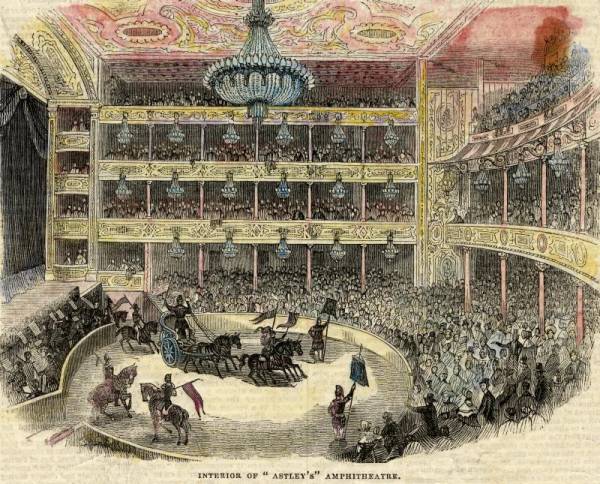
Son of a Newcastle cabinet maker, Philip Astley (1742-1814) is regarded as the father of the modern circus. His auspicious beginnings were as a cracking rider, and his entrepreneurial spirit. When he noticed trick riders received a crowd of attention in Islington’s entertainment district, he figured he would give it a try.
Being a former military man, the Sergeant Major must’ve known he would have to outmaneauver competitors. Therefore, instead of riding in a straight line like other trick riders, Astley came up with the circle riding style (which gave birth to the application of circus to the ring style show).
More than his entrepreneurial riding, Astley was a definite showman. Frost (1875) tell us:
After performing near the Westminster Bridge a limited circus, with tumblers and “droll” dressed riders (which would morph into clowns) Astley was able to save money to erect his ampitheatre. By 1780, “Astley’s soon became a popular place of amusement for all classes. Horace Walpole writing to Lord Stafford says ‘London at this time of the year September is as nauseous a drug as any in an apotheicary’s shop. I could find nothing at all to do and so went to Astley’s which indeed was much beyond my expectation I do not wonder any longer that Darius was chosen King by the instructions he gave to his horse nor that Caligula made his Consul. Astley can make his dance minuets and hornpipes. But I shall not have even Astley now Her Majesty the Queen of France who has as much taste as Caligula has sent for the whole of the dramatic persona to Paris.”
Like so many other buildings of its era, the Ampitheater for Astley’s circus was destroyed numerous times in the 1790s and 1800s by fire. For a brief time, the circus had a home in the Lyceum Theater (ab. 1794).
Astley died in 1814 at the ripe old age of 72 (not bad for a danger mouse in the Regency) and was succeeded with moderate success by his son, John Astley, who died seven years after his father.
My personal favorite bits of the modern circus, the animals, were indeed part of the Regency travelling circus.
Again, Frost’s invaluable book on the circus fills us in on the details of the menagaries:
Austen mentioned Astley’s in Emma, and although only in passing conversation, it is as sure a sign as any that this entertainment was a solid piece of Regency history.
There is lots more information about Astley and his circus available on the wide web.
Here are some suggestions for further reading:
http://www.circopedia.org/Philip_Astley










Pingback: Regency Rites: The London Season | Susana's Parlour